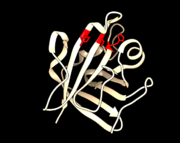Sandbox sortases
From Proteopedia
(Difference between revisions)
| Line 35: | Line 35: | ||
== Industrial and Laboratory Applications == | == Industrial and Laboratory Applications == | ||
| - | Sortases may be very useful in the lab as they can be used to attach a variety of probes to any protein. The probe contains the LPXTG recognisiton sequence for S. aureus SrtA (or LPXTA for Streptococcus pyogenes SrtA) and the target protein acts as the nucleophile in the active site. The reaction can be accomplished in less than three hours <ref>Theile, Christopher S, et al. ‘Site-Specific N-Terminal Labeling of Proteins Using Sortase-Mediated Reactions’. Nature Protocols 8.9 (29 Aug. 2013): 1800–1807.</ref>. Sortases can also be used for in vitro protein ligation. They can ligate a peptide with the correct motif to an aminoglycine peptide. They can also be used to conjugate synthetic branched peptides, (d)-peptides, and aminoglycine-derivatized small molecules to the C terminus of any recombinant protein | + | Sortases may be very useful in the lab as they can be used to attach a variety of probes to any protein. The probe contains the LPXTG recognisiton sequence for S. aureus SrtA (or LPXTA for Streptococcus pyogenes SrtA) and the target protein acts as the nucleophile in the active site. The reaction can be accomplished in less than three hours <ref>Theile, Christopher S, et al. ‘Site-Specific N-Terminal Labeling of Proteins Using Sortase-Mediated Reactions’. Nature Protocols 8.9 (29 Aug. 2013): 1800–1807.</ref>. Sortases can also be used for in vitro protein ligation. They can ligate a peptide with the correct motif to an aminoglycine peptide. They can also be used to conjugate synthetic branched peptides, (d)-peptides, and aminoglycine-derivatized small molecules to the C terminus of any recombinant protein<ref>Mao, H, et al. ‘Sortase-Mediated Protein Ligation: A New Method for Protein Engineering’. Journal of the American Chemical Society. 9.126 (5 Mar. 2004): n.pag. 4 Nov. 2015. </ref>. |
</StructureSection> | </StructureSection> | ||
== References == | == References == | ||
| - | 1. McCafferty, Dewey G., and Jeffrey A. Melvin. ‘Sortases’. Handbook of Proteolytic Enzymes. N.p.: Elsevier BV, 2013. 2459–2465. PDF. | ||
| - | |||
| - | 2. Spirig, T, EM Weiner, and RT Clubb. ‘Sortase Enzymes in Gram-Positive Bacteria’. Molecular microbiology. 5.82 (27 Oct. 2011): n.pag. 4 Nov. 2015. | ||
| - | |||
| - | 3. Maresso, Anthony W., Travis J. Chapa, and Olaf Schneewind. ‘Surface Protein IsdC and Sortase B Are Required for Heme-Iron Scavenging of Bacillus Anthracis▿’. 188.23 (29 Sep. 2006): n.pag. 4 Nov. 2015. | ||
| - | |||
| - | 4. Theile, Christopher S, et al. ‘Site-Specific N-Terminal Labeling of Proteins Using Sortase-Mediated Reactions’. Nature Protocols 8.9 (29 Aug. 2013): 1800–1807. | ||
| - | |||
| - | 5. Mao, H, et al. ‘Sortase-Mediated Protein Ligation: A New Method for Protein Engineering’. Journal of the American Chemical Society. 9.126 (5 Mar. 2004): n.pag. 4 Nov. 2015. | ||
<references/> | <references/> | ||
Revision as of 18:48, 11 December 2015
This page is setup for Brandon to build his senior project for OU CHEM 4923
Sortase System
| |||||||||||
References
- ↑ 1.0 1.1 1.2 1.3 1.4 1.5 McCafferty, Dewey G., and Jeffrey A. Melvin. ‘Sortases’. Handbook of Proteolytic Enzymes. N.p.: Elsevier BV, 2013. 2459–2465. PDF.
- ↑ 2.0 2.1 2.2 2.3 2.4 Spirig, T, EM Weiner, and RT Clubb. ‘Sortase Enzymes in Gram-Positive Bacteria’. Molecular microbiology. 5.82 (27 Oct. 2011): n.pag. 4 Nov. 2015.
- ↑ Maresso, Anthony W., Travis J. Chapa, and Olaf Schneewind. ‘Surface Protein IsdC and Sortase B Are Required for Heme-Iron Scavenging of Bacillus Anthracis▿’. 188.23 (29 Sep. 2006): n.pag. 4 Nov. 2015.
- ↑ Theile, Christopher S, et al. ‘Site-Specific N-Terminal Labeling of Proteins Using Sortase-Mediated Reactions’. Nature Protocols 8.9 (29 Aug. 2013): 1800–1807.
- ↑ Mao, H, et al. ‘Sortase-Mediated Protein Ligation: A New Method for Protein Engineering’. Journal of the American Chemical Society. 9.126 (5 Mar. 2004): n.pag. 4 Nov. 2015.

